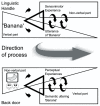Words as cultivators of others minds
- PMID: 26594187
- PMCID: PMC4633484
- DOI: 10.3389/fpsyg.2015.01690
Words as cultivators of others minds
Abstract
The embodied-grounded view of cognition and language holds that sensorimotor experiences in the form of 're-enactments' or 'simulations' are significant to the individual's development of concepts and competent language use. However, a typical objection to the explanatory force of this view is that, in everyday life, we engage in linguistic exchanges about much more than might be directly accessible to our senses. For instance, when knowledge-sharing occurs as part of deep conversations between a teacher and student, language is the salient tool by which to obtain understanding, through the unfolding of explanations. Here, the acquisition of knowledge is realized through language, and the constitution of knowledge seems entirely linguistic. In this paper, based on a review of selected studies within contemporary embodied cognitive science, I propose that such linguistic exchanges, though occurring independently of direct experience, are in fact disguised forms of embodied cognition, leading to the reconciliation of the opposing views. I suggest that, in conversation, interlocutors use Words as Cultivators (WAC) of other minds as a direct result of their embodied-grounded origin, rendering WAC a radical interpretation of the Words as social Tools (WAT) proposal. The WAC hypothesis endorses the view of language as dynamic, continuously integrating with, and negotiating, cognitive processes in the individual. One such dynamic feature results from the 'linguification process', a term by which I refer to the socially produced mapping of a word to its referent which, mediated by the interlocutor, turns words into cultivators of others minds. In support of the linguification process hypothesis and WAC, I review relevant embodied-grounded research, and selected studies of instructed fear conditioning and guided imagery.
Keywords: derived embodiment; embodied cognition; first-order language; linguification; other minds; ‘back door’ entry; ‘linguistic handle’.
Figures


References
-
- Anderson M. L. (2014). After Phrenology: Neural Reuse and the Interactive Brain [E-Reader Version]. Available at: https://mitpress.mit.edu/books/after-phrenology - PubMed
LinkOut - more resources
Full Text Sources
Other Literature Sources

